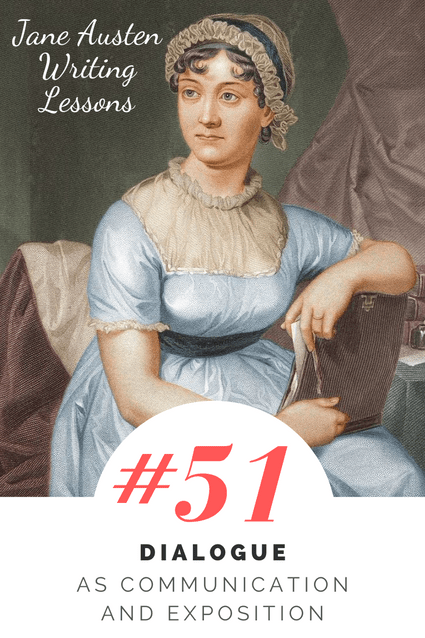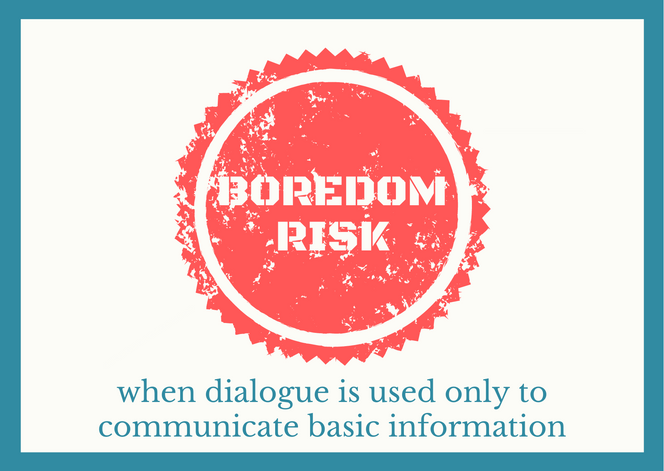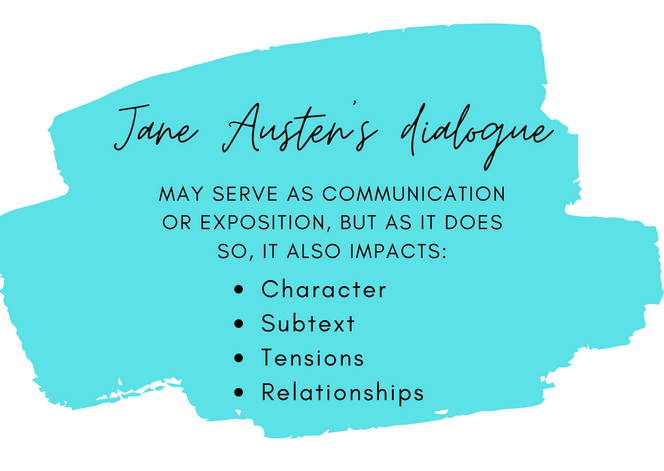In Jane Austen’s Persuasion, our first introduction to Admiral Croft comes through dialogue. Sir Walter’s friend, Mr. Shepherd, tells Sir Walter that an Admiral Croft has made an offer to rent Kellynch Hall:
“And who is Admiral Croft?” was Sir Walter’s cold suspicious inquiry.
Mr Shepherd answered for his being of a gentleman’s family, and mentioned a place; and Anne, after the little pause which followed, added–
“He is a rear admiral of the white. He was in the Trafalgar action, and has been in the East Indies since; he was stationed there, I believe, several years.”
“Then I take it for granted,” observed Sir Walter, “that his face is about as orange as the cuffs and capes of my livery.”
These brief few lines of dialogue are masterful: information is communicated from Mr. Shepherd and Anne to Sir Walter, and exposition is provided for the reader. We quickly know the most relevant details about Admiral Croft, and we’ve learned how each of these characters feels about these details.
In the hands of Austen and other talented writers, dialogue can be a powerful tool for conveying information, or, in other words, communication.
Oxford Languages defines communication as “the imparting or exchanging of information or news.” In everyday life, one of the primary purposes of speech is to communicate—to give and receive information. You convey information when you tell someone what to buy at the store, summarize the latest news, schedule a meetup, inform someone that you’re running late, create a plan, share what happened at work or school, repeat what someone said to you, or give background that helps someone understand the context for a situation or events.
Because dialogue is such an effective method of communication in everyday life, the temptation is to use it to give information to the reader—and it can be an effective tool to communicate exposition and other background information at the start of the story, or to communicate other information or news that is relevant later on in the story.
Yet if the purpose of a dialogue is simply to communicate information, it often feels boring and out of place.
It is too easy to lose the reader as they are forced to slog through endless details. At other times, dialogue feels stilted, like it’s being said just the reader can know the information, and not for an organic purpose within the conversation. Bad dialogue often contains background information that the characters would have no reason to talk about in the present, or, if it is information the characters would talk about, it contains extra details simply for the readers’ sake.
In my early drafts, I often have dialogue that solely conveys information, and even if it’s exactly what someone would say in real life, it’s often dry and doesn’t forward the story or help the characters. A lot of the time I realize that I convey this information another way, such as a quick summary or a scene where people are acting and doing. Sometimes I spread the information out across multiple scenes, piece by piece (see this post on how Austen incorporates backstory). Other times I revise the dialogue so that dialogue is performing double or triple-duty—I want my dialogue to do more than simply convey information.
Whenever Jane Austen uses dialogue to convey information or exposition, the dialogue also reveals aspects of character, includes subtext, shows or creates tension, or impacts a relationship.
Take, for example, this moment of exposition near the beginning of the novel Persuasion, that sets up key background information on the characters and their situation. Both Anne Elliot and her friend Lady Russell know that Anne’s father, Sir Walter Elliot, has ruined his finances and spent well beyond his means. They work together to create a plan of retrenchment for him:
“If we can persuade your father to all this,” said Lady Russell, looking over her paper, “much may be done. If he will adopt these regulations, in seven years he will be clear; and I hope that we may be able to convince him and Elizabeth, that Kellynch-hall has a respectability in itself, which cannot be affected by these reductions; and that the true dignity of Sir Walter Elliot will be very far from lessened, in the eyes of sensible people, by acting like a man of principle….I have great hope of our prevailing. We must be serious and decided.”
While this piece of dialogue conveys information, it is engaging because it is a rehearsal—Lady Russell is trying to convince both Anne and herself that this plan will work, despite their knowledge of Sir Walter. These lines reveal Lady Russell’s character—her concern for the family, her rationality, her sense of morality, and her optimistic approach to life. There is tension, because this is not just a plan, it is a plan of attack, and the characters do not know if it will work.
We see Lady Russell’s plan, the information of what she plans to convey. Because we already know Lady Russell’s approach and the type of arguments she will use, Jane Austen does not give us Lady Russell’s actual words to Sir Walter, for doing so would repeat information and lessen the impact. We do however receive Sir Walter’s reaction:
Lady Russell’s [suggestions] had no success at all—could not be put up with—were not to be borne. “What! Every comfort of life knocked off! Journeys, London, servants, horses, table…”
Another scene which conveys a large amount of information is the one is which Anne goes to stay with her married sister Mary. Yet while it conveys information about where the characters are, what they are doing, their health, etc., it is interesting because of what it reveals about Mary’s character, Anne’s character, and their relationship with each other:
Mary greets Anne:
“So, you are come at last! I began to think I should never see you. I am so ill I can hardly speak. I have not seen a creature this whole morning!”
“I am sorry to find you unwell,” replied Anne. “You sent me such a good account of yourself on Thursday!”
“Yes, I made the best of it; I always do; but I was very far from well at the time; and I do not think I ever was so ill in my life as I have been all this morning—very unfit to be left alone, I am sure. Suppose I were to be seized of a sudden in some dreadful way, and not able to ring the bell!….”
Anne said what was proper, and enquired after her husband. “Oh! Charles is out shooting. I have not seen him since seven o’clock. He would go, though I told him how ill I was….”
Anne has chosen to stay with Mary rather than travel with her father Sir Walter and sister Elizabeth to Bath. She has chosen this, knowing who her sister is and what her life will be like staying with her sister. There is so much subtext—so much that is not stated—about what Anne wants, the quiet role she has been relegated to, and the relationship she has with her family members.
This dialogue is the first scene in which we see Mary before us. The information that is conveyed—when they last wrote, Mary feeling ill, and Charles out shooting—is much less important to the narrative than everything else the dialogue reveals.
If you need convey information to your reader, or have your characters convey information to each other, it is important to consider whether or not dialogue is the best approach to do so. If dialogue is used, make sure that the dialogue is doing more than simply conveying information—it’s a powerful tool to reveal characters, show or shift relationships, create or convey tension, and demonstrate subtext.
Exercise 1: Analysis
Read the first chapter or two of a novel, and track when and how information and exposition is given. When is it given through the dialogue? What other approaches are used to provide information and exposition? When information and exposition are given through dialogue, what else is the dialogue doing?
Exercise 2: Dialogue Tracking
Spend a day tracking the times you speak with other people. How many of your conversations were communication—giving and receiving information? Of those times where you were giving or receiving information, when was there subtext, interesting things with character or emotion or relationships or something pivotal happening because of the conversation?
Exercise 3: Making Information Compelling
Choose a basic set of information that two characters might need to convey, such as a shopping list, a homework assignment, or a plan for meeting up. Write a dialogue which conveys this information but is interesting and compelling because of what it conveys about characters, relationships, tension, or subtext.






